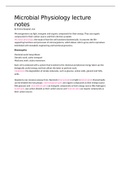Microbial Physiology lecture
notes
By Emma Burgwal, wur
Microorganisms use light, inorganic and organic compounds for their energy. They use organic
compounds for their carbon source and their electron acceptor.
Microbial physiology: the study of how the cell functions biochemically. It concerns the life-
supporting functions and processes of microorganisms, which allows cells to grow and to reproduce.
Interlinked with metabolic engineering and functional genomics.
Bioenergetics
Chemical work: biosynthesis
Osmotic work: active transport
Mechanic work: active movement
Each cell is endowed with a system that transforms the chemical and physical energy taken up into
biologically useful energy and that utilizes the latter to perform work.
Catabolism: the degradation of simple molecules, such as glucose, amino acids, glycerol and fatty
acids.
Organisms can conserve energy from chemicals (chemotrophs) or light (phototrophs). Chemotrophs
can be divided into two groups: chemoorganotrophs use organic compounds as their energy source
(like glucose) and chemolithotrophs use inorganic compounds as their energy source (like hydrogen).
Autotrophs use carbon dioxide as their carbon source and heterotrophs use organic compounds as
their carbon source.
,Energy is defined as the ability to do work. All chemical reactions in a cell are accompanied by
changes in energy, energy being either required or released as a reaction proceeds (AH + B <-> A +
BH).
How do you know if
energy is being
required or released? You can know this with the
chemical potential (μ). If the potential is equal, there
is an equilibrium.
Chemical potential is
also known as partial
molar free energy, a
form of potential energy that can be absorbed or
released during a chemical reaction.
Endergonic: energy required, exergonic: energy released.
-ΔGf0 is the Gibbs free energy of formation from the elements
for compounds of biological interest.
There are two partners in a redox reaction: an electron donor
and an electron acceptor (the half cells). A more negative E 0
gives a better electron donor, a more positive E 0 a better electron acceptor (as seen in the redox
tower). The redox tower goes from negative potentials (the top) to the positive potentials (the
bottom). When two couples react, the reduced substance of the couple, whose E 0 is more negative,
donates electrons to the oxidized substance whose E 0 is more positive. The formula shows how much
free energy can be released during coupling, where n is the number of electrons and f the Faraday
constant.
Change in Gibbs energy is equal to the maximum amount of work that can be done by the reaction.
Change in Gibbs energy is a measure of displacement from equilibrium.
The true Gibbs energy can be determined by the constant K.
Activation energy is the minimum input of energy to start a reaction (see image).
Energy can be coupled. This is called syntrophy. The image below shows an example of coupling two
reactions; one reaction is exergonic, the other one
endergonic.
A known example of syntrophy is interspecies hydrogen
transfer.
Electrons need electron carriers to go from one place to
another. An example of an electron carrier is NADH.
Respiration occurs in the presence of inorganic electron
acceptors, sometimes in presence of oxygen (aerobic
respiration). This is called electron transport
phosphorylation (ETP). Fermentation has no external electron acceptors.This is called substrate level
phosphorylation. In the image, the left one is aerobic respiration and the right one is fermentation.
, The formation of ATP is directly connected to a biochemical reaction. It is generated by the direct
transfer of an energy-rich phosphate molecule from a phosphorylated compound to ADP (=substrate
level phosphorylation; SLP). This type of reaction can also occur with different compounds, like the
formation of GTP by phosphorylation of GDP.
Acyl phosphates are called high energy compounds, because their standard free energy of hydrolysis
is more negative than -30 kJ/mol.
ATP is synthesized via an electrochemical gradient (usually a proton gradient) that is build up via
membrane-bound redox processes. ETP is important during aerobic and anaerobic respiration.
Cytoplasmic membranes are impermeable for H and OH. Electron transport results in the
translocation of protons and this proton gradient is the driving force for ATP synthesis.
H-carriers e-carriers
NADH, FADH2 Cytochromes
Quinones Fe-S proteins
Flavoproteins
Explanation of the carriers: examples of flavins are NAD and FAD. Quinones are hydrophobic, non-
proteins containing compounds. Flavoproteins contain flavins prosthetic groups. It can accept two
electrons or two hydrogen atoms, but can only donate electrons to the next compound in the chain.
Cytochromes contain a heme prosthetic group (iron atom) which can donate and accept only one
electron. Fe-S proteins carry electrons. The reduction potentials vary depending on the amount and
the position of the Fe and S molecules.
In contrast to SLP where you need at least 45 kJ, in ETP smaller energy packages can be used for ATP
synthesis (of 1 proton). 3 or 4 protons are needed for 1 ATP.
ATP synthesis is reversible.
There are other ways to create membrane potentials, via transport coupled phosphorylation, light
energy (membrane pomp gets activated by light which works as a proton pomp) and by building up
ΔNa (sodium gradient).
Cells can’t store ATP, because it is a dynamic molecule. Microorganisms produce insoluble polymers
for long-term energy storage.
Catabolism
Stages in mineralization of complex carbon: hydrolysis (breaking of food in smaller molecules),
glycolysis and then fermentation (without oxygen or oxidized inorganic molecules) or respiration.
Degradation of major polymeric substrates into soluble products is catalysed by exoenzymes (for
example: proteases for proteins).






